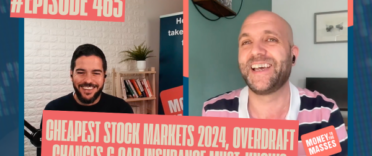The 18th episode of my weekly podcast show where I discuss what is happening in investment markets and what to look out for. Each show lasts between 10-15 minutes and is aimed at DIY investors (including novices) seeking contemporary analysis to help them understand how investment markets work. This week I demonstrate the power of having an investment process in turbulent markets.
Click on the media player below to listen to Episode 18 of Damien's Midweek Markets podcast.
Other ways to watch, listen and subscribe
You can listen to other episodes and subscribe to the show by searching 'Money to the Masses' on Spotify or by using the following links:
Alternatively, you can watch the video for this week's show on our youtube channel or via the player below
Transcript - Episode 18 of Damien's Midweek Markets
Hello and welcome to the latest edition of Damien's midweek markets, the show where I talk about what's been going on in investment markets and what to expect in the weeks ahead. It's been two weeks since we last did this show and there's been a lot that's gone on. We've seen the trade war escalate, at the point we did the last show, we were waiting to see if the trade war would escalate and what China would do.
There have been retaliatory measures by China, one of the biggest things that's driven markets is the idea that the Chinese may be starting to sell their holding of US Treasuries. Of course, Trump has been ramping up his rhetoric, he also had an attack on Mexico in terms of claiming he was going to apply tariffs to imports from Mexico if they didn't try and stop the amount of immigration that was coming across the Mexican / US border.
So it has certainly ratcheted up a notch and it is clear that the 50-day moving average on the S&P 500 is key. Would we break below the 50-day moving average and perhaps even move below 2,800? Would we go lower, to 2,790 and the 200-day moving average? As the trade war rhetoric escalated and both sides antagonized one another, we saw a sell-off in US equities and equities globally. What had started at the beginning of May continued right towards the end of May and we saw markets fall down and the S&P 500 in particular crash through those lower levels, setting up quite a bearish picture.
Since then, we started to push through 2,800 and we got all the way down to 2,700 and the market seemed to find some support and then rebound. So it leads me to ponder how was your May? For anyone who follows 8020 investor and my 50k portfolio (which is a portfolio I run live on 8020 investor) I tell you what I'm buying and what I'm selling at the time that I do it. My portfolio actually made money in May which given that markets had collapsed, was pretty impressive. There are 400 funds in the two managed sectors that cover the 40 to 85 percent shares and equities. Funds that have between 40 and 85 percent in stocks and the rest perhaps in bonds and the other sector, which is a little bit lower risk that can have somewhere between around 20 to 60 percent in equities.
My portfolio outperformed both of those sectors, not just the averages, we're talking about all 400 funds in there. Obviously I'm pleased about that, but why I mention it is because you might want to check out 8020 investor and a free trial, but more importantly, it's about the power of a process. So the markets really popped in April they jumped higher but what we're seeing is almost a replay of the beginnings of what occurred in December (eg. bond yields are selling off). It doesn't mean the markets are necessarily going to collapse from here, but we're seeing lots of negative headlines, we're seeing bond yields collapse around the world, we're seeing the yield curve invert once again almost globally wherever you picked.
If you look at the stock market (get your stock market app out on your Smartphone). You can look at the S&P 500 and see that nice rally into September time then dip down into December and then it bounces again leading into this year. We've now hit a double top, at least it looks like a double top; it hasn't been completely confirmed. Where the market has hit that resistance level we had near all-time highs, it has now pulled back; is it going to keep going lower? The bond market on the other hand if you look at the TNX (if you type in TNX on your app) you'll see the 10-year US Treasury yield. If you look at that going back over that same period (six months or further back into September), you will see there's a steady decline in the Treasury yield.
There have been moments where it has actually rallied, but go back to September when we were up over 3% on the US Treasury 10-year yield and everyone was telling you it was going to go to 4%, we are now down towards 2.12% at the time that I write this post. Bond yields have been collapsing, so what that says is there's fear in the market or that the market is pricing in a recession. What's been interesting in the last couple of weeks we've seen lots of indicators alongside the US trade war escalation, suggesting that we are heading towards a recession and some economists are saying that we are already in one. Don't forget that when you see GDP numbers that are officially published, they are always backwards-looking; so you don't actually find out that you were in a recession until many many months later.
So the question now is are we going to get a sustained pullback or are we going to bounce back to new highs? What we saw in the last couple of days is the S&P 500 rebound and that was largely because we had the US Federal Reserve starting to make noises that if we enter a recession, then they won't be afraid to cut interest rates. So there's a lot of hope out there and a lot of hope around the ECB today, that there might be some dovish moves by them and the early indications are that after that meeting, they weren't as dovish as people had hoped.
So there's a lot of hope in this rally that we've had in the last couple of days, it took the S&P 500 back above 2,800 which is a key support level. It'll be interesting to see what happens when the market approaches that 50-day moving average, are we going to get a re-test and another failure? Are we going to get a pattern such as a zigzag down? We don't know yet but
there's a lot of negative headlines out there at the moment a lot of negative sentiment.
Collapsing bond yields, collapsing economic data so it's not a great picture but, that's not to say that we won't have a lot of buyers come into the market and buy the dip. So we've got to wait to see what happens in the next couple of days and weeks and particularly it matters what Donald
Trump says on the trade war front. As I write this post, he's already making more noises towards ramping up tariffs (which the market hasn't liked), so we're in a bit of a limbo now and we could just be moving sideways for a period. We've had a pullback though, so there is definitely some negative sentiment brewing out there which has caught a lot of people by
surprise, which is why my portfolio outperformed so many people in the month of May.
It wasn't just US Treasury yields that have been falling, bonds have been rallying; they've had an amazing rally and a particularly good May (meaning there could be a bit of a pullback on those), but what it means is that anything like UK gilts has performed really well, particularly in my portfolio during the month of May. They don't have the currency exposure that you get when you have global bond funds and what we've also seen in the equity space is anything that's got a quasi bond feel to it is rallying as well. So that means utilities and also REITs (property equities) have done well in the last month or so and particularly in this rally. It doesn't mean that they haven't lost money, but they've definitely outperformed the rest of the market.
In the coming days look out for any noises made by the Fed and other central banks around the world. Keep an eye on the trade war with Donald Trump and particularly what China is doing, because China is starting to show signs of retaliating and almost withdrawing completely from trade war discussions. That will have implications for the market going forward and obviously economic conditions. 80-20 investors will have already seen some stuff about the importance of not upsetting your bank manager (that's the dynamic between China and America) so you will understand the importance of what happens in the US Treasury yield market has on equities going forward.
One other piece of research I will be doing for 8020 investor members is the oil price. The price of oil has collapsed and that is likely to have implications for the equity market going forward which again, I will come back to at a later date. One final thing before we finish, Neil Woodford; if you're into investing you can't have moved for the last couple of days without hearing about Neil Woodford and the closure of one of his main funds. I'm going to pick up that theme on this week's podcast, so make sure you listen out for that on Sunday. It's a show that's going to be covering a lot of lessons that can be learned. It's not just about whether you invested in Woodford or not, but other lessons to learn; much wider lessons relating to the world of finance and DIY investing. That is it for this week if you want to get in touch then you can, usual ways @money2themasses on Twitter, [email protected] is my email.
Until next week



